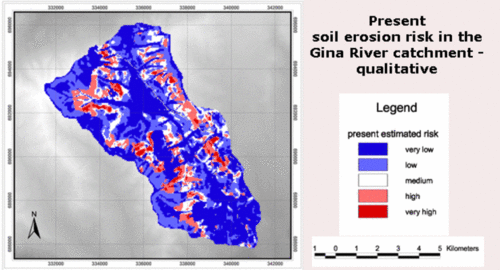Qualitative approach
Soil erosion risk in the Gina River catchment in 2003 assessed after a qualitative approach
Image Credit: Adapted from Beck et al. 2004
Alongside the semi-quantitative approach a qualitative approach was applied to estimate soil erosion risk in the Gina River catchment. To avoid a reduced reflection of the reality as in many available models that consider only a limited numbers of factors and processes a holistic approach was tried. Thus, a variety of natural and human factors contributing to soil erosion in the individual landscape units were considered. Natural factors that were accounted are related to relief, soil, and precipitation. Factors reflecting human impact are land use and soil conservation measures.
Based on the recorded soil erosion damages during field work damage classes have been developed qualitatively in order to distinguish differently affected soil erosion damage areas. Three classes have been determined by the extent of soil erosion damages (low – medium – high). As soil erosion damages can be mainly explained by two factors these were considered in the qualitative assessment of soil erosion risk:
- land use
- relief.
Other factors affecting soil erosion were not integrated into the assessment:
- soil conservation measures – as these occur only punctually and thus, irrelevant for an area-wide estimation
- precipitation / torrential rainfall events – due to the lack of data
- soil characters – as the investigation of soil focussed on the appraisal of curve numbers only, other soil parameters were not detected.
The combination of land use and relief indicates soil erosion risk in the Gina River catchment (figure). The pattern of the soil erosion damage class distribution is highly overlapping the areas of soil erosion risk as you can see from the figures.
Afterwards, a comparison between both introduced approaches to assess soil erosion risk was drawn. This is presented next.

